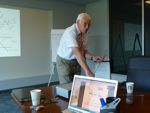Much of any optical system consists of a succession of optical surfaces that direct and manipulate the light. Their properties are rarely ideal. Any desired modification to these properties implies application of an optical coating. The optical design of these coatings in itself is a demanding task. Then there is the manufacture. Adding to the difficulties are the frequent requirements that not only should the coating have superior optical performance but it must usually improve also the environmental resistance of the underlying component.
Optical coatings consist of one or more layers of thin material deposited over the surface. Their optical performance is determined by a mixture of interference effects and their intrinsic optical properties. The exact calculation of coating performance uses well-established principles but nevertheless is a complex, difficult and tedious task. It is therefore normally, invariably, carried out by computer and there are many powerful computer software packages for this purpose. Accurate calculation, however, does not necessarily imply understanding and understanding is a prerequisite if we are to succeed in the field of optical coatings.
The fact that the computer can readily calculate accurately the optical properties of coatings permits us to concentrate on understanding and there are a number of useful tools that help considerably in this. One of these tools is the admittance diagram, a major topic in this course.

It is impossible to cover the entire field of optical coatings in just a few lectures. The course, therefore, concentrates on the fundamental tools that are used to understand and calculate the properties of thin film multilayer coatings. Knowledge of the material should then make individual study of published material straightforward.
The course consists of a series of lectures together with a set of notes. The notes contain the course content in the order in which it was given. It is not a verbatim reproduction of the lectures but it does contain the important material. The learning process is always a difficult one requiring considerable application and part of the reinforcement necessary for material to be learned and retained is writing it down. Thus we do recommend that additional notes be taken during the course. Repetition also improves retention and one of the great advantages of a video course is that it may be repeated many times.
- Complex Numbers: Light is a form of wave motion. Calculation of the interference of light waves involves both the amplitudes and the relative phases of the various waves. It is almost impossibly difficult to deal with complicated interference problems without the aid of complex waves. A complex wave implies the use of complex numbers. The first part of the course, therefore, is a simple explanation, or revision, of complex numbers and the complex plane. This may be safely omitted by those already familiar with the concept. Running time 31 minutes.
- Complex Waves: The complex harmonic wave is a concept that is fundamental not only in coatings but also in optics in general. This section explains the complex wave concept and includes a number of conventions and definitions. Running time 20 minutes.
- Optical Admittance, Refractive Index and Irradiance: This section defines many of the parameters required in the study of optical coatings. The concept of optical admittance is particularly important and must be understood before the admittance diagram can be introduced. Running time 37 minutes.
- Admittance Transformers and Admittance Loci: An introduction to the idea of thin films as admittance transformers, to admittance loci and to the admittance diagram where the admittance loci are traced. Running time 29 minutes.
- Some Applications of the Admittance Locus: Application of the admittance loci and the admittance diagram in understanding the performance of various optical coatings. Running time 59 minutes.
- The Matrix Method: In the most powerful technique for the calculation of the properties of optical coatings each layer is represented by a characteristic matrix. This lecture explains how the properties of a thin film are derived, introduces the idea of a matrix and the rules for its use and explains how it can be used to represent the properties of a thin film. The matrix method is then extended to multilayers. Running time 1 hour 11 minutes.
- Oblique Incidence: Interference phenomena depend on the path differences between the various beams and because these path differences depend not only on the spacing between the various interfaces in the system but also on the direction of propagation of the light relative to these interfaces there is a dependence in the properties of any optical coating on the angle of incidence of the light. Not only do the properties change but there is also a dependence on polarization. This section of the course introduces the student to these important phenomena and shows how they may be calculated. Running time 1 hour.
Please contact Thin Film Center for more information.
The Instructor

All products and services may be ordered directly from Thin Film Center or from any of our agents. For your convenience we accept payment by American Express, Mastercard and Visa. Please contact us, or our agents for pricing information.

2745 E Via Rotunda, Tucson, AZ
85716-5227, USA
Telephone: +1 520 322 6171
Email: info@thinfilmcenter.com
